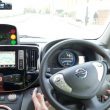Driverless tech must ride out the storms to come
Navigation products are being released all the time promising drivers the ability to take into account extreme weather conditions.
Matthew Avery, director of insurance research at Thatcham Research, reminds us that drivers need to be aware of the weather at all times in order to ensure that they drive safely. Connectivity can permit them to know what’s ahead of them, allowing them to, for example, adjust their speed and maintain enough distance between them and other vehicles to account for increased braking distance in rainy, snowy and icy road conditions.
He comments: “Firstly, people need to slow down because of reduced visibility but sensor visibility (both camera and radar) have compromised visibility as well, they suffer just like the driver, therefore they need more space and room to react.
“Advanced driver assistance systems (ADAS) currently use either radars or cameras to monitor the environment, e.g. traffic and pedestrians, and react accordingly. These systems can then automatically brake the vehicle (AEB) to help avoid or mitigate a collision.”
At Level 5 of autonomy, the same principle applies except it’s the vehicle itself that needs to be aware of its surroundings to be able to adapt its driving appropriately to the weather conditions it faces at any given moment. Safety, after all, whether human-driven or autonomous is of paramount concern for the autonomous vehicle and its passengers.
Varying development
Saarinen Jari, CTO of full stack autonomous driving software developer for all weather conditions Sensible 4, reveals that autonomous vehicles are currently at various stages of development around the world. Not all of the developers are aiming for Level 5 autonomy: some are more focused on remotely assisting Level 4 autonomous vehicles on pre-defined routes.
He explains: “This sort of Level 4 approach appears to be one major trend, as more and more technology providers find Level 5 too difficult. We can also see the sensor technology taking major leaps forward. The LiDAR’s are becoming more affordable while they improve their measuring performance. The methods to use existing automotive radars improve. We see new 5G technologies emerging, improving the connectivity of the vehicles and enabling new applications.”
To read the complete article, visit TU-Automotive.

















